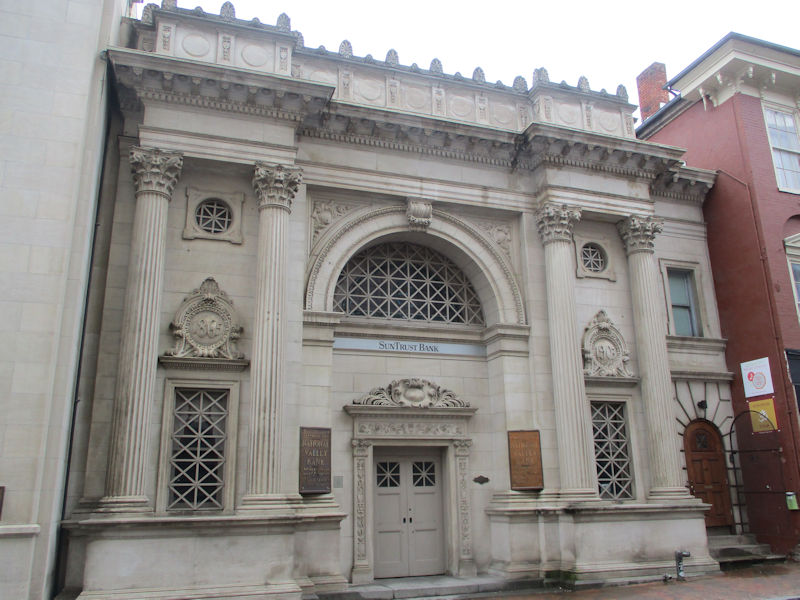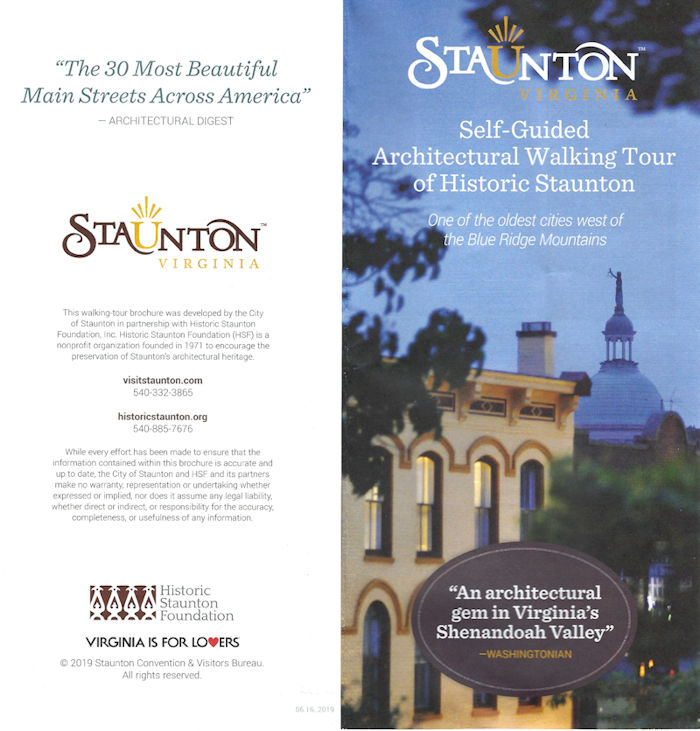You may not find this terribly rewarding unless you're included here, so this is a good time for casual and random browsers to turn back before they get too caught up in the sweep and majesty of the proceedings and can't let go.
5 January 2022
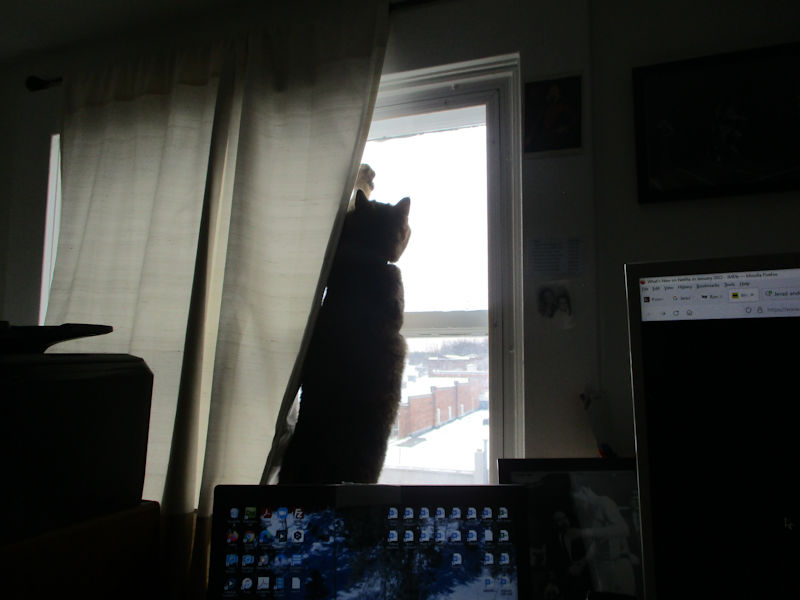
Melvin greets the new morning with a wave to the neighbors.
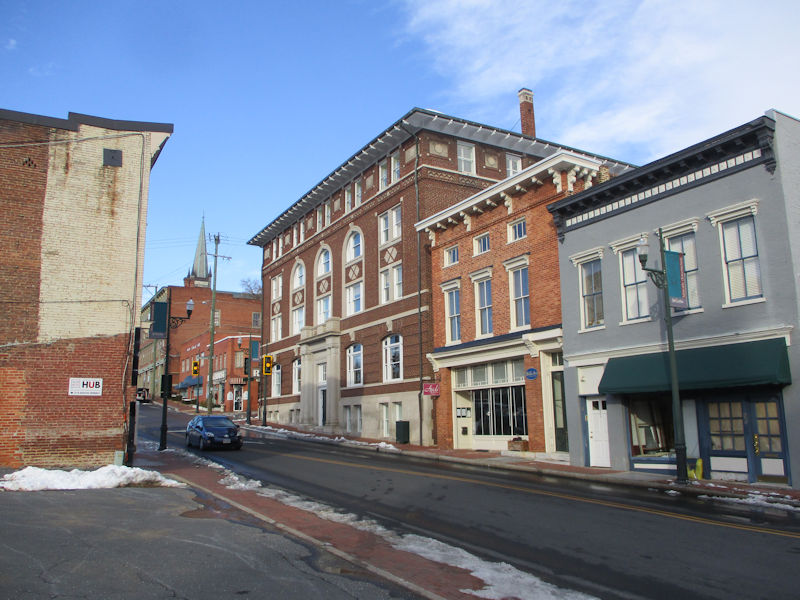
We're hopelessly besotted with Staunton's architecture and sometimes wake up from a kind of fugue state, standing in front of our Old Y condo building (above) with our little Canon PowerShot filled with photos of attractive and interesting houses that must just have caught our fancy.
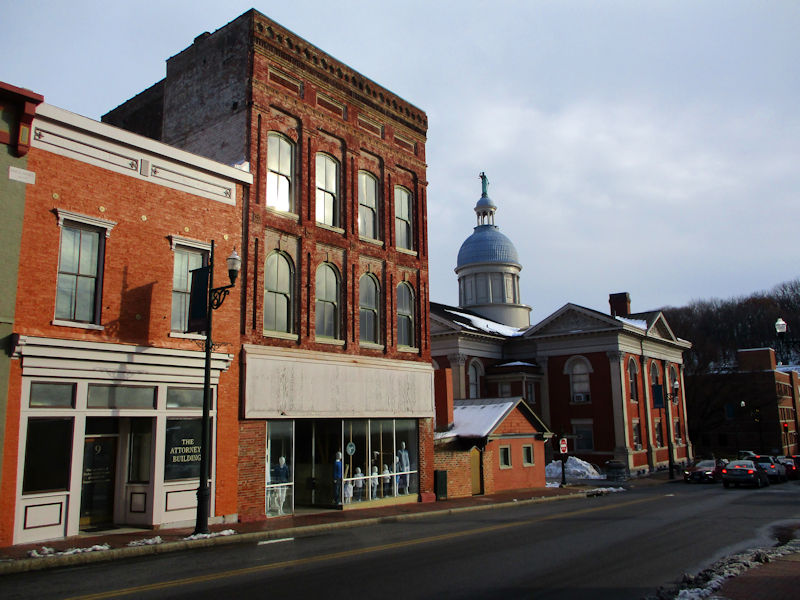
Unfortunately, despite long years of eclectic education, the study of architectural styles and trends has either escaped us or been forgotten altogether. Luckily, we have in hand the city's handy Walking Tour Guide to some of the best architectural wonders of the five Historic Districts (see samples far below), and will try to fake the rest.

That's an attractive and symbolic cliché on the dome of the Augusta County courthouse (T J Collins design, 1901). An anchor of the Wharf District -- sadly, the whole issue of this County courthouse and possible successors that will destroy the historic buildings of the whole city block turns out still to be up for grabs, as the awful new four-person 'conservative' majority on the City Council are still pursuing their secret machinations, and there's no light at the end of this tunnel of corruption at the moment.

The happy face of the Pufferbellies toy shop, and the Mary Baldwin Univ meetings annex, along Johnson St, facing the huge open-air carpark

And that's one of the two public parking garages, the Johnson St bldg; the other is the New St bldg farther along Johnson St down a few blocks behind us.

This, we judge, is a very well designed sign; tastefully informative, etc. We all know about the antiques, dining, and shopping are about, and we scarcely ever miss a Saturday Farmer's Market when we're in town, but we pause to wonder what services are being promised here.
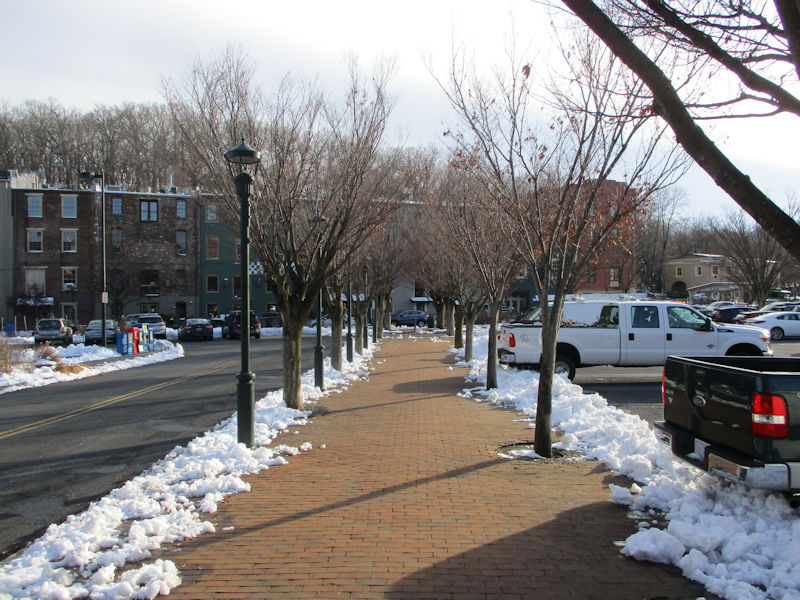
Civic symmetries, a fine brick-paved processional

We've moved along out Middlebrook Ave, now in front of the Table 44 restaurant, and we're looking up at the spectacle of Church St's good stuff arrayed in serried ranks all the way up the hill. We'll take a closer look in a moment; let anticipation grow.

First, we'd like to admire this admirable railroad bridge, presently employed by the Amtrak passenger train the 'Cardinal' and various miles-long freight trains, but predating Amtrak by a long march. We're pacing along a convenient pedestrian bypass parallel to Middlebrook Ave to the left and the notorous Lewis Creek just over the railing on the right.
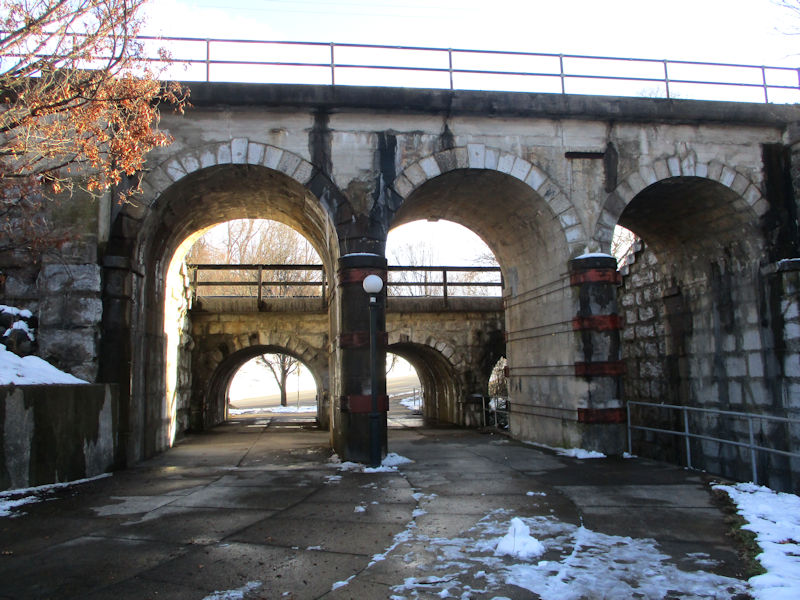
The foreground bridge is the Amtrak link to Chicago and New York City; the farther one leads into the yards of the Buckingham Branch, an 'active trans-load site', whatever that means (sticking train freight onto trucks, or something?). They make for a good photo; last year we came upon a wedding party doing their formal photos under the bridge.
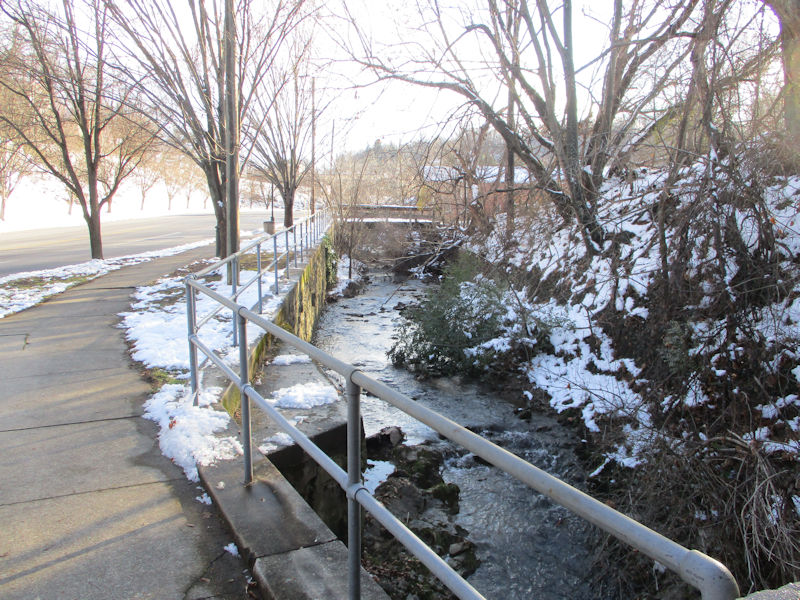
That's the infamous Lewis Creek, which comes down out of the mountains to the west and leads eventually to the Chesapeake Bay by a succession of riverine mergers too tedious to recount here. Normally it dribbles along here at the bottom of this sort-of-ditch, but when the waters rise, there's no place for it to go. The summer of 2020 got some serious flooding, and one gathers that there have been much worse episodes in the past.
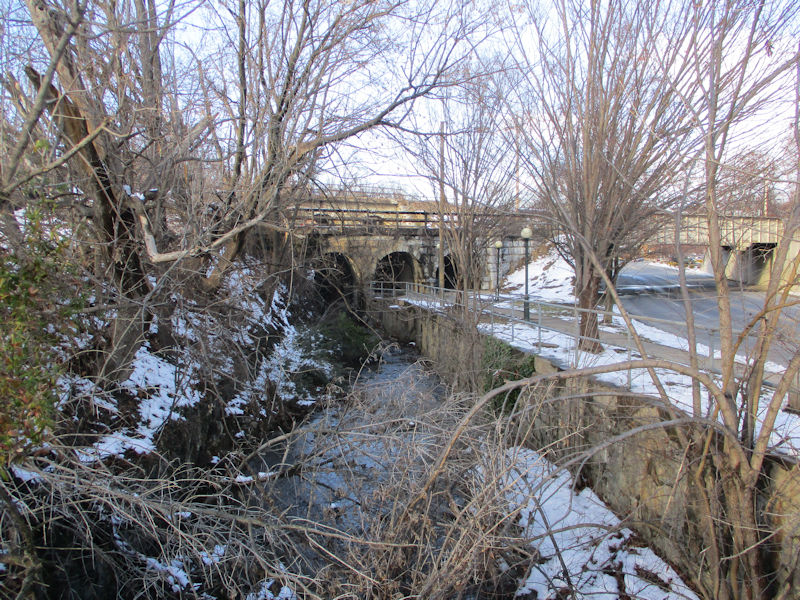
The Lewis Creek, looking back into town (we're turning round now, bound for Church St).
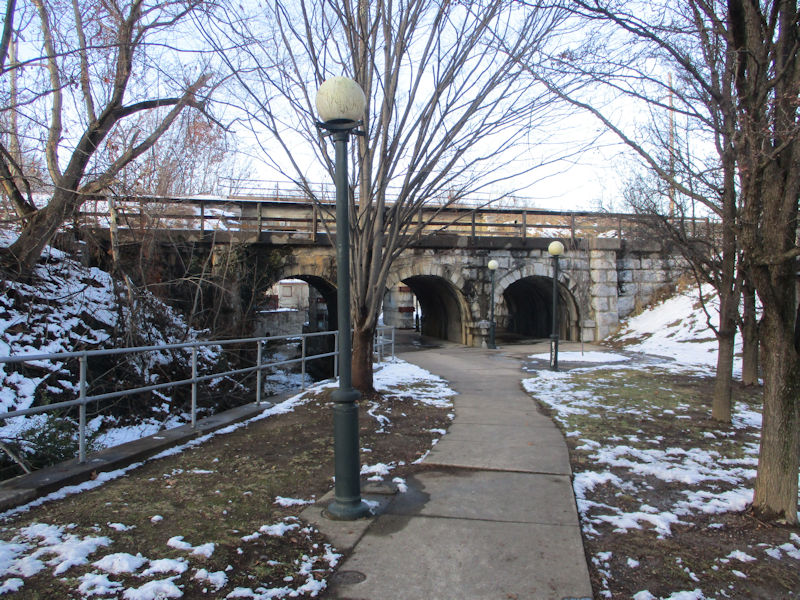

That's the Lewis Creek entering the Wharf downtown district but burrowing under the Sunspots Glassblowing Studio and then the entire length of the Wharf Parking Lot (what could go wrong?).

The interesting array of verandas, etc., up the western side of Church St.

Starting with this one: a pleasant porch leading to a protruding 'ell' or extension, with a bay window hanging out the front . . .
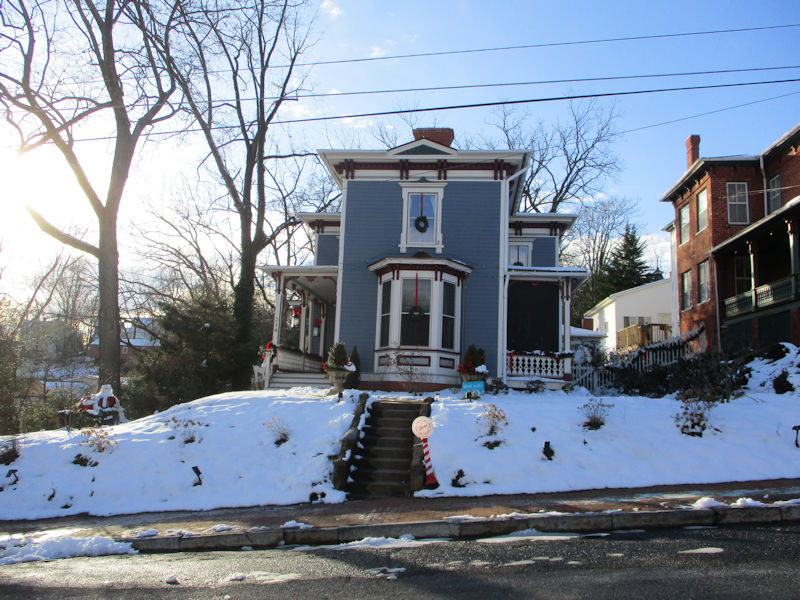
Talk about symmetries -- two pleasant porches leading back to protruding ells (squint just a bit, and it can look like an incoming US jet fighter plane with bomb-laden wings -- you're toast).

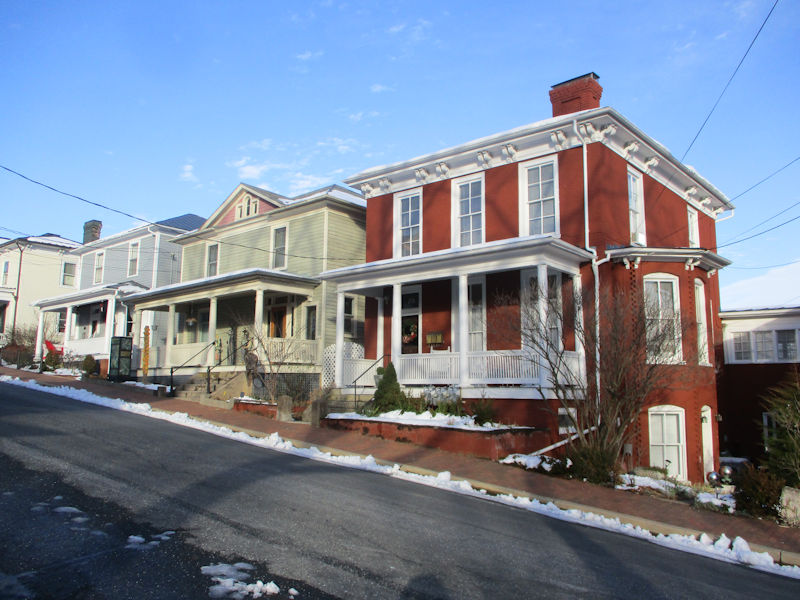
On the eastern side of Church St, a varied parade of front porches.

That's a fascinating little place. Historical Stauntonians did love their ornate porches, often wrap-around verandas, their projecting windows, in most neighborhoods their regular upkeep and repaintings, and in many neighborhoods their polygonal towers. Maybe that's down to southern traditions, or maybe we can thank T J Collins for establishing the basic motifs.

Verandas and ells -- often in brick, but often in wood as well.
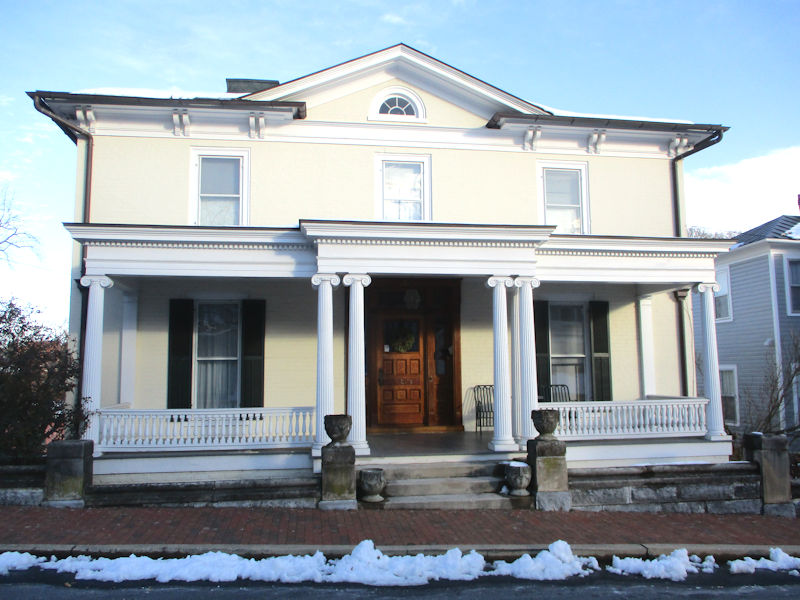
We're in the Newtown District at the moment, at the corner of Church and Federal

204 Church St, porch steps that keep your options open to the last second
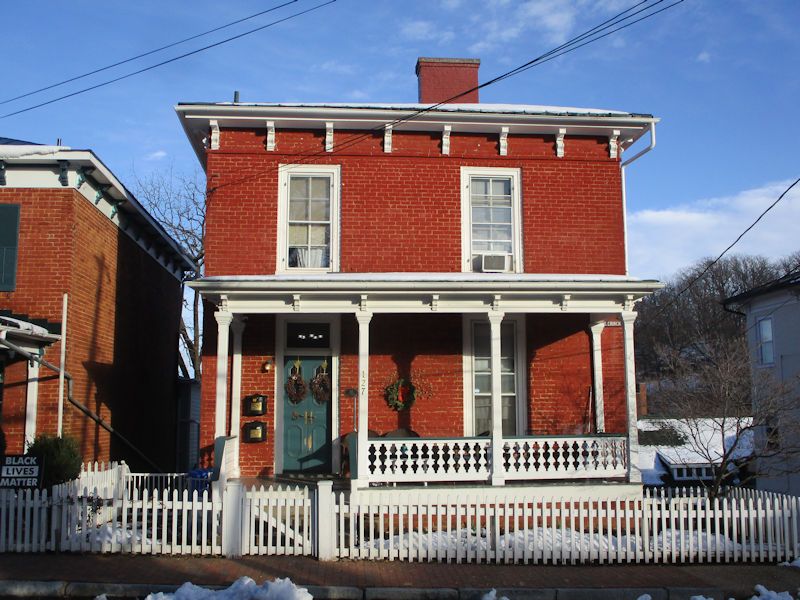
127 Church, also on the corner of Church and Federal, a classic little fella

This, however, is somewhat more upscale, if not necessarily cozier. This is 'the Stuart House, one of Virginia's earliest Classical Revival buildings', built by Judge Archibald Stuart in 1791, with the addition stuck onto it by his son in 1844.
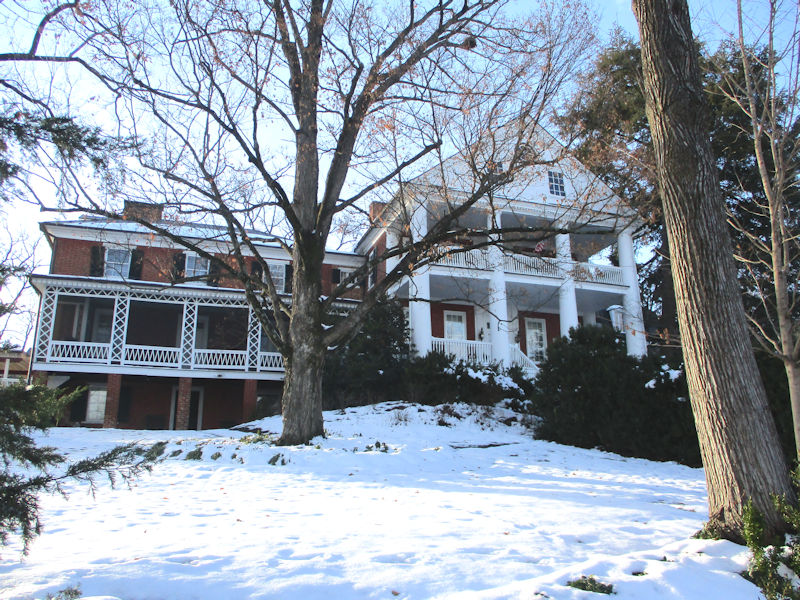
Very grand. Servants up under the eaves.
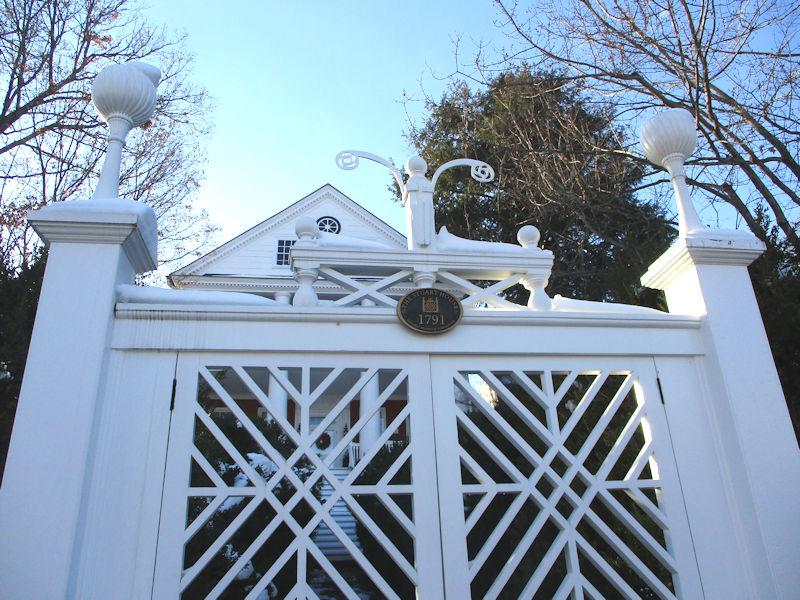
There's said to be a cottage round the back, built in 1785, where the worthy judge resided whilst this big thing was being built.

Continuing along Church St

'And now for something completely different'
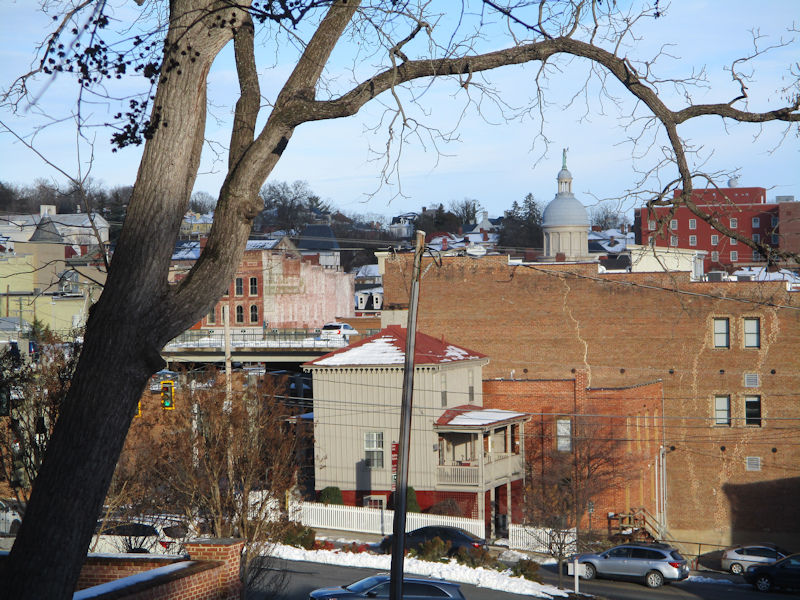
Amongst all the ponderous brickwork, that little frame building, facing onto Johnson St in (officially) the Wharf District, is worth a second look. In a moment.
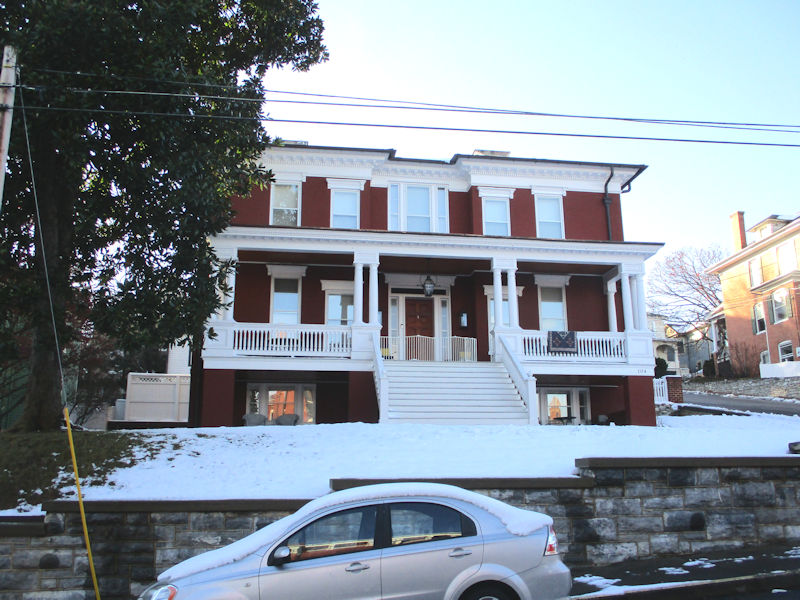
104 Church St at the intersection with Johnson . . .

. . . seen from an angle.

. . . and 103 Church just across the street, with . . .

. . . the hind end of 103 from below.
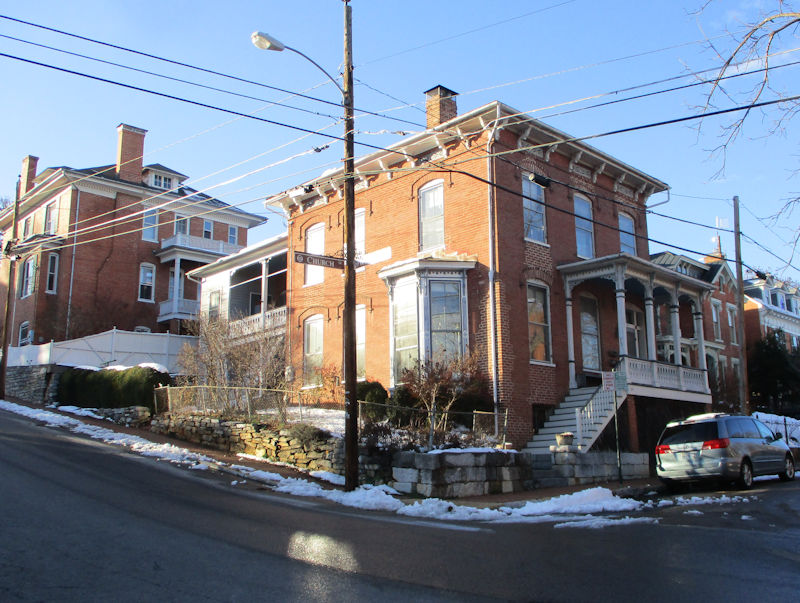
Also at Church and Johnson
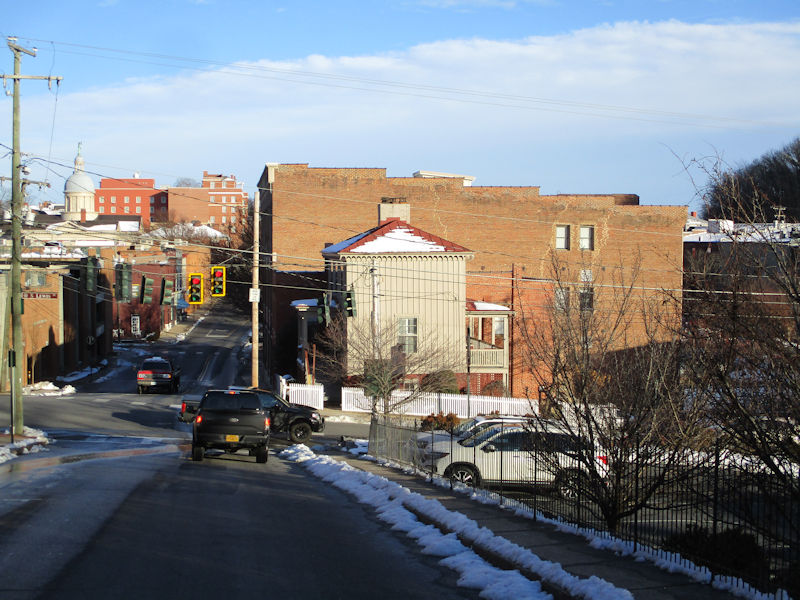
We're descending precipitously down Johnson St into the downtown -- there's our little frame building.

One of the best uses of church property we're likely to find, a children's playground (with a few benches for reading on, but with deference for watchful parents)

The Trinity Episcopal Church was founded in 1746 and the first permanent building on this site came along in 1763. The present church, facing onto Beverley St, was built in 1855 with subsequent improvements. This on Johnson St is shown on Google Maps as the 'Old Trinity Church', but is actually the Parish House from 1872.
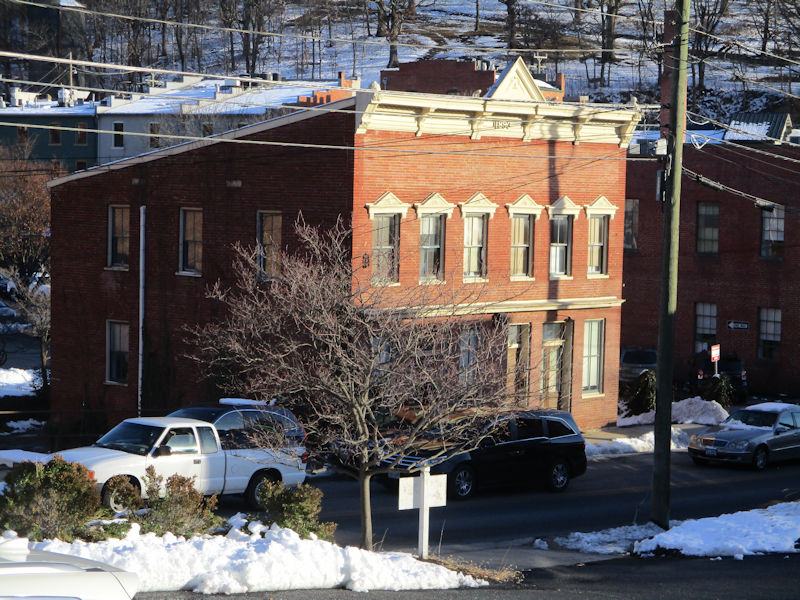
Just down near the base of Lewis St, this building from 1893 was once the source of 'Dr Hite's Pain Cure', 'which claimed to cure everything from headaches to gangrene'. It's presently the home of The Shop, which appears to be a well-recommended hair salon.
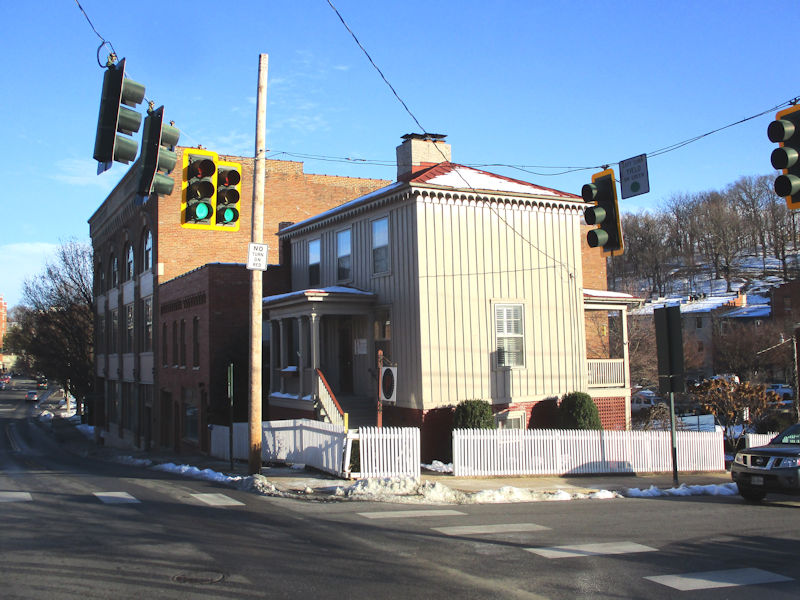
Finally we come to 118 W. Johnson St, considered to be the 'oldest unaltered house in the downtown', dating from ca. 1854.
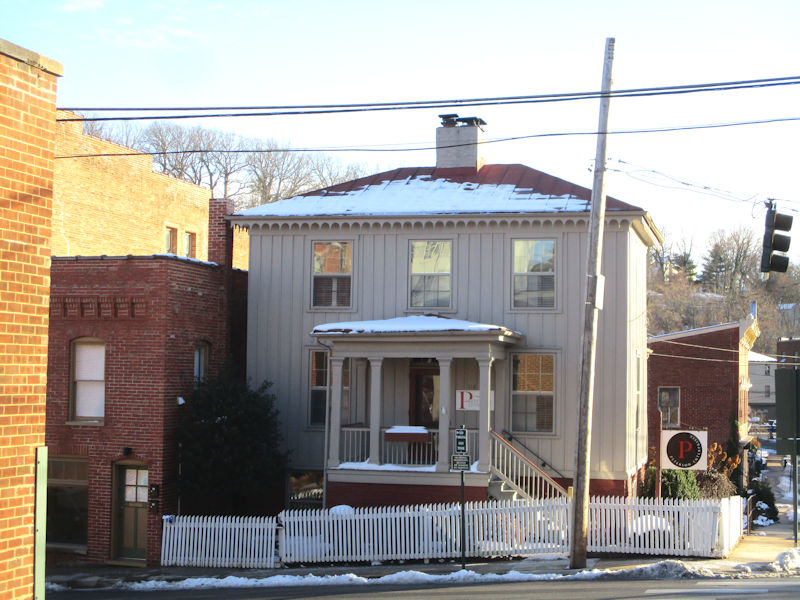
It's now occupied by Peterson Enterprises, apparently the home office of a group of carwash locations in Virginia, West Virginia, and Maryland.

Walking up Lewis Street from Johnson, we're traversing another of Staunton's parades of churches -- here on the left, the associated buildings of the Trinity Episcopal Church; next on the corner of W. Beverley, the Central United Methodist Church; and on the corner of W. Frederick, just beyond those red traffic lights, the Second Presbyterian Church (not the First Presbyterian, that's three blocks over by us). We probably have as many churches in town as we have banks.
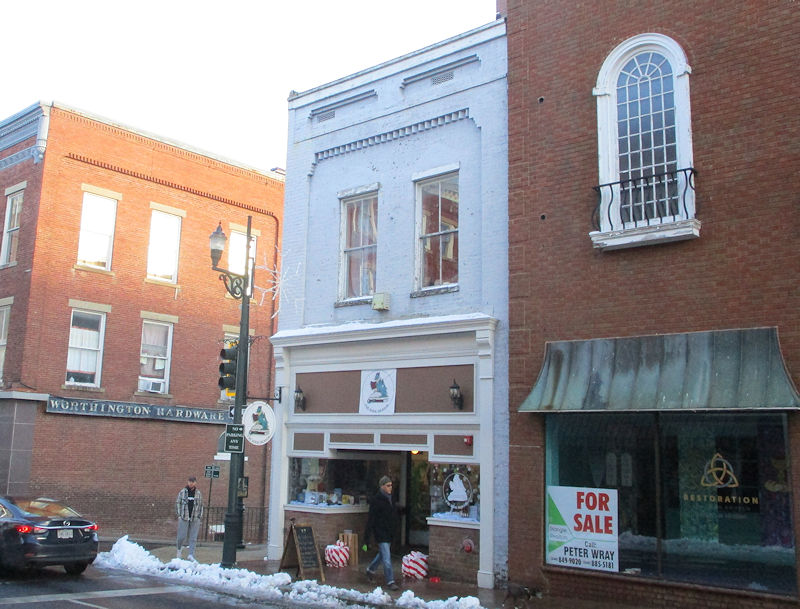
The lovely Book Dragon Shop on W. Beverley, and the Restoration Anglican Church Staunton ('a part of the Diocese of Christ Our Hope of the Anglican Church in North America, ACNA) (evidently up for sale at the moment). [This is not the same as the Anglican Church of the Valley, part of the ACNA Diocese of the Mid-Atlantic, with its office and Wisdom Bookstore on Middlebrook Ave facing the train depot and services in the Temple of Israel synagogue -- the Church of the Valley is expressly the 'Bible-based' one.]

Speaking of churches, here on N. August St are two establishments poised to answer our spiritual or pizza needs, respectively, should they ever be required.
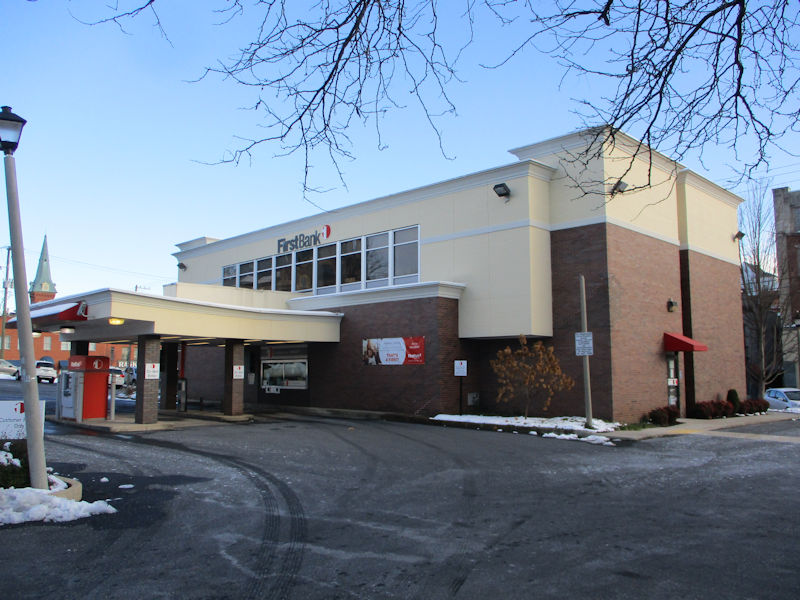
Here, to our grief, begins the N. Central Ave Bankers' Row -- as the story goes, there was once 'a thriving community' along N. Central Ave, mostly African-American, when the City Council decided to bulldoze it and build some kind of a super-mall, using an urban renewal grant, to make the downtown more commercially attractive. The grant or the mall deal fell through, we're told, and they ended up with 416 meters, a quarter of a mile, of flat nothing. That's the First Bank, just across the street from our Old Y condo.
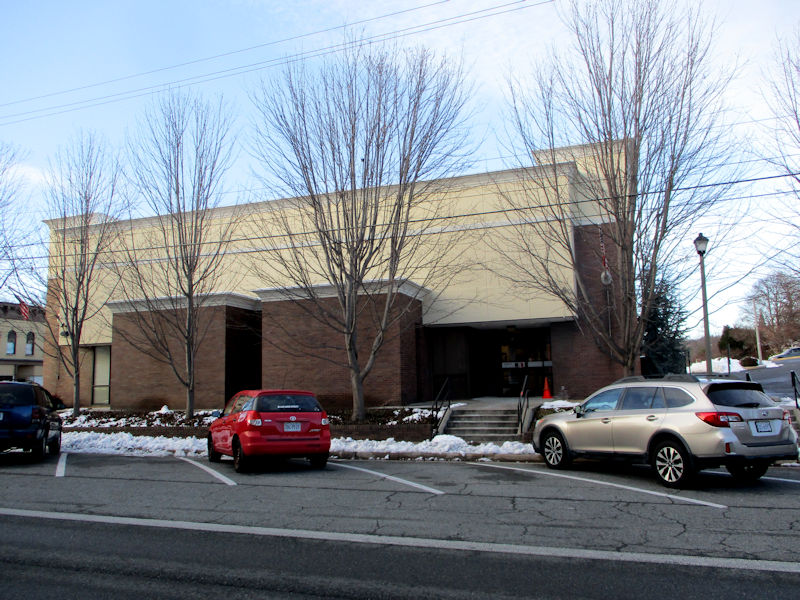
It's built in the venerable Fortress Style, and that seems to be the little front door there on the right. Defended by a portcullis probably. What Staunton eventually got in exchange for its 'thriving community' was four cookie-cutter banks, a credit union, a Hardees, and a Dominos Pizza. Good job.
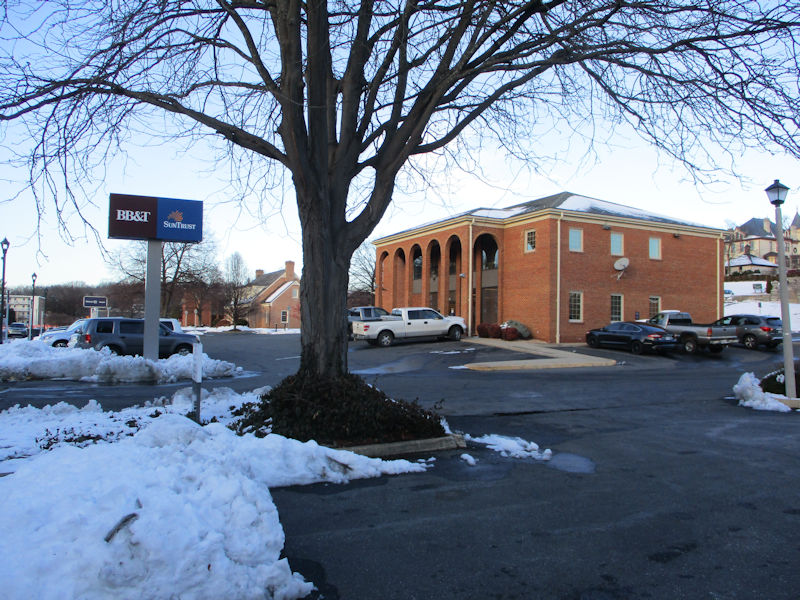
That's number two, my bank actually, with its rather inexplicable curtain of column-like things out front. Staunton has two fine parks -- Gypsy Hill and Montgomery Hall -- but a real shortage of just ordinary green spaces with comfortable all-weather benches for citizens to come along with a book or a picnic lunch and sit outside in the sun. What if these underused banks were to contribute some space for some tastefully arranged benches for a grateful public.
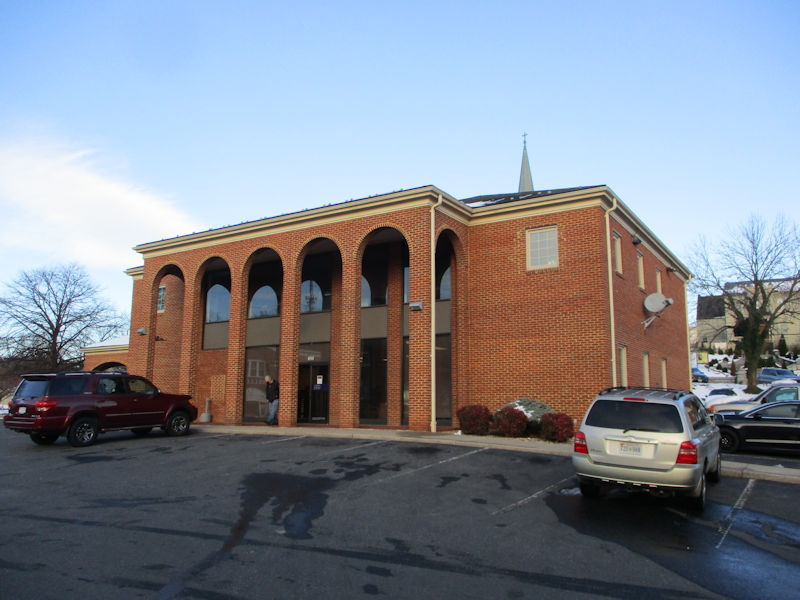
The first bank, called the First Bank, had 24 parking slots around it, nearly all of which are usually empty. This one has 49 slots, with a few used by staff and fewer by clients, most of whom bank on-line these days. And what is the name of this bank, anyway?
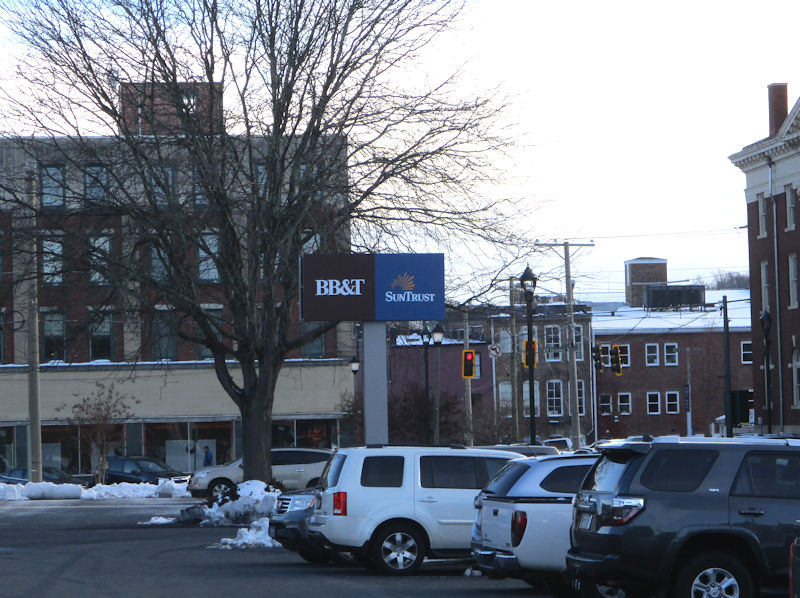
Well, the sign over the parking lot calls it the BB&T (Branch Banking & Trust Co.) but the adjoining one identifies it as the SunTrust. What's that about?
But the SunTrust Bank is no more, sort of. It's been merged into the BB&T over the past many months, slowly, painfully, and together they are now called, as one . . .
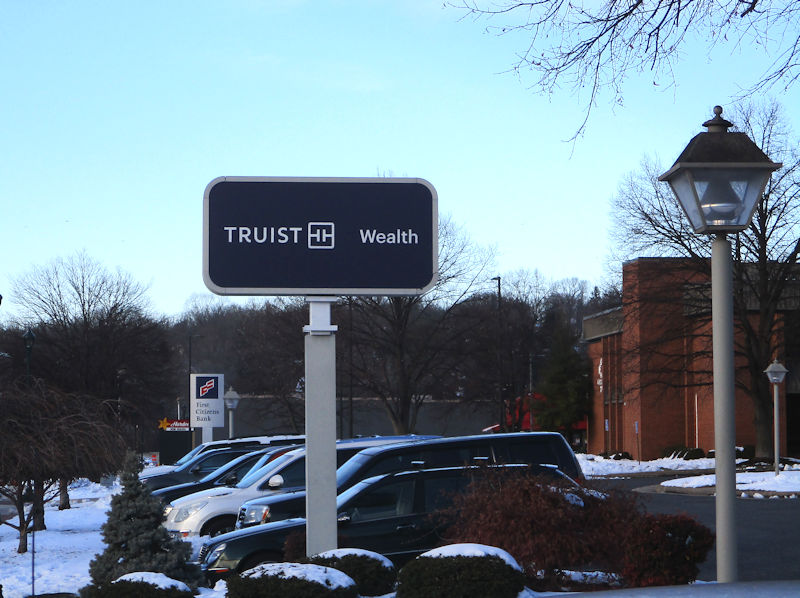
Truist! Awful name. It sort of suggests 'truth' but doesn't really. The 'wealth' part just sounds aspirational.
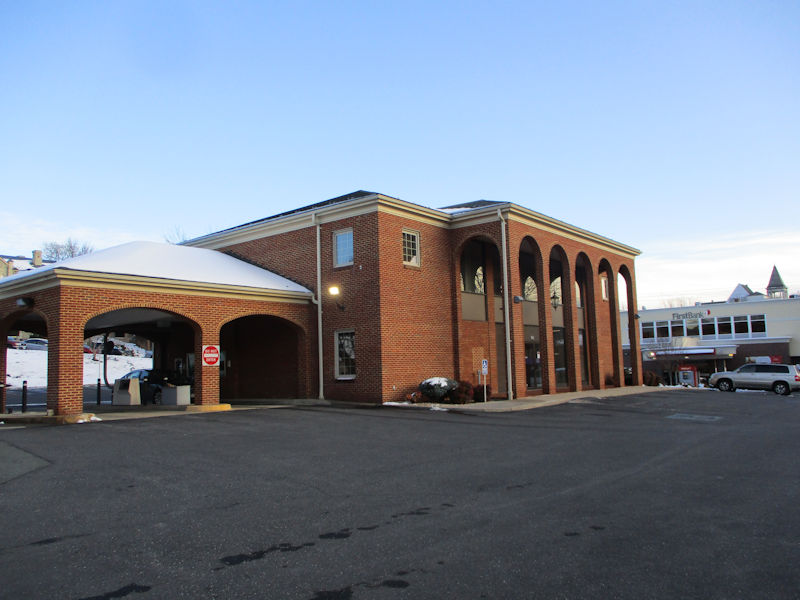
The combined on-line bank accounting works well, but if you go inside to consult a teller or advisor, you line up for either the SunTrust window or the BB&T window. I've only been in twice, because for routine banking who needs a physical fortress. The ATM outside is useful. But it's painful that we traded in our old vintage bank building for this Monument to Something or Other.
(If you squint, it can look like a lumbering mastodon.)
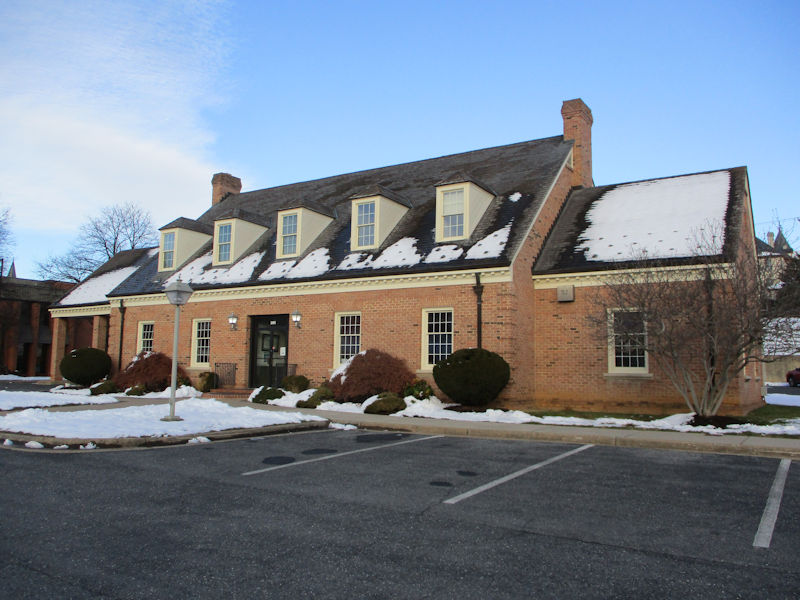
The third bank along the row has no obvious identification, but (this is where the 'wealth' part comes in) it appears that at least some of the place houses an office of Scott & Stringfellow, an investment banking firm founded in 1893 that became known as BB&T Scott & Stringfellow as of 2013 after a $131 million stock transaction. It is now a division of BB&T Securities, which is owned by Truist Financial. Whew!
There are 33 parking slots here, and as far as we've seen, none of them has ever been used. (How about some benches then, yeah?)
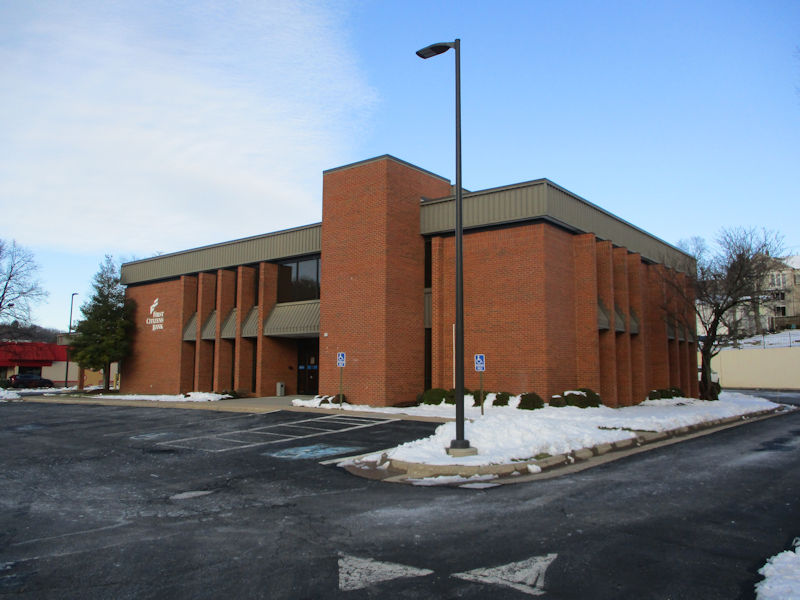
Fourth in line, this is the First Citizens Bank (not the First Bank, that was number one) with a similarly empty parking lot -- 31 spaces but no takers. It is either the First Bank for Citizens or, arguably, the Bank for First Citizens. Beyond that, the DuPont Credit Union only has about 18 slots or so, but there's an empty adjacent field, possibly benchable.
Hardees just farther along ('hiring Crew Members, $10/hr') has 52 parking slots, only a few in use (probably staff) but a very busy drive-in window, with 9 or 10 cars lined up at a time for breakfast and lunch. Dominos has about 8 slots, nearly all occupied, if at all, by delivery staff with colorful little plastic dominos strapped on top of their cars -- but it's just for take-out, evidently, and couldn't help with our bench problem anyway.
The Growing Together Fellowship (at 261 N. Central, just past the Hardees: 'a non-denominational church': 'our mission is to simply love God and love people') has 43 parking slots, none at all in use when we've passed by but likely all filled up at 10 a.m. on Sundays and 7 p.m. on Tuesdays. They're working in a good cause and should get to keep all their potential bench sites for better uses, but the banks, now, they're another story.
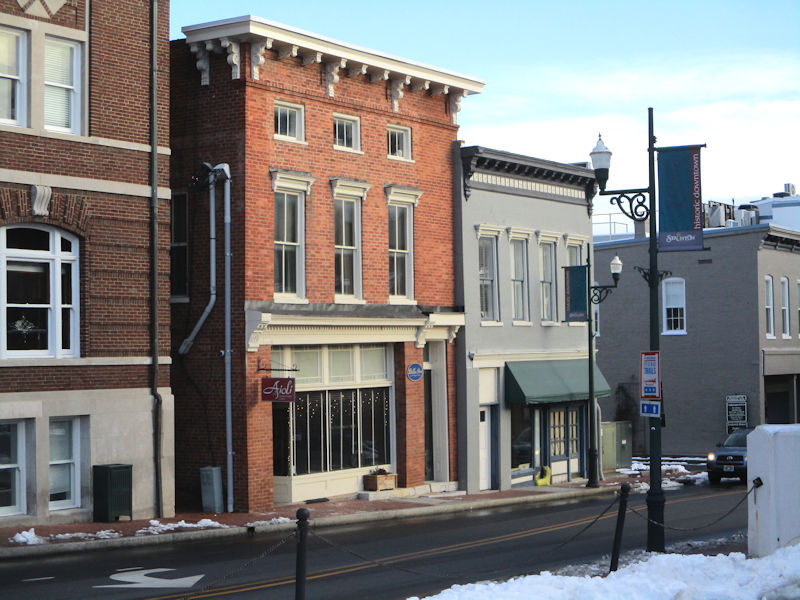
Well, it's never going to happen. We've identified only four public benches within sensible walking distance of the Old Y, and we feel that the appalling City Council should be grappling with the city's bench shortage instead of working funky secret deals about courthouses and city staff purges. (232 mostly unused parking spaces -- that could be more than 600 benches, rows and rows of them.)

Overnight -- we're meant to be getting more snow tonight, but it's not happening. Mixed feelings.

Across from our front door, Eric Stamer's Catering establishment is requiring masks to enter as per the Governor's Executive Orders and as per Eric's Order!
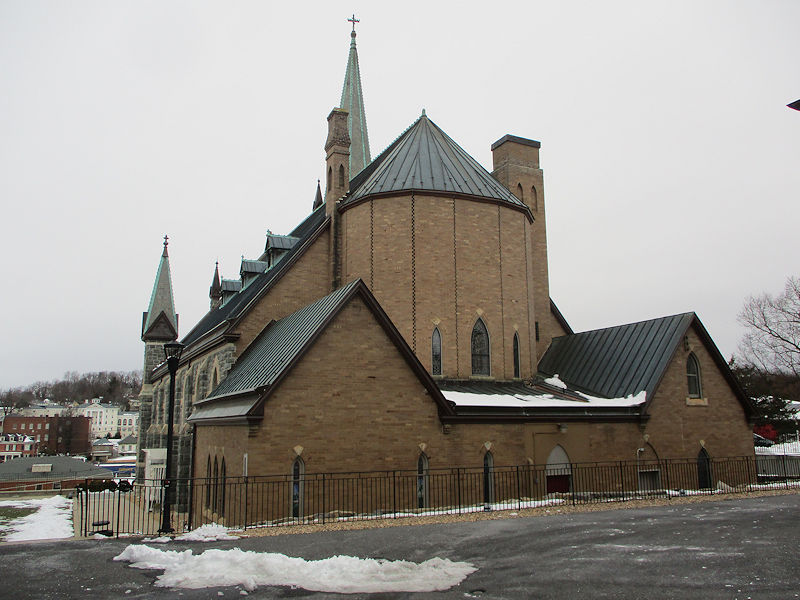
An early-morning constitutional, 6 January, here round the apse of T J Collins' Gothic Revival St Francis of Assisi church (1895), replacing an earlier one from 1851 . . .

. . . overlooking our BB&T, or SunTrust, sorry Truist bank, already doing some drive-in window business. The five cars in the foreground are in the free public slots on N. Augusta Street. There are almost no cars at all in the BB&t/SunTrust/Truist property (one staff member, lower left).
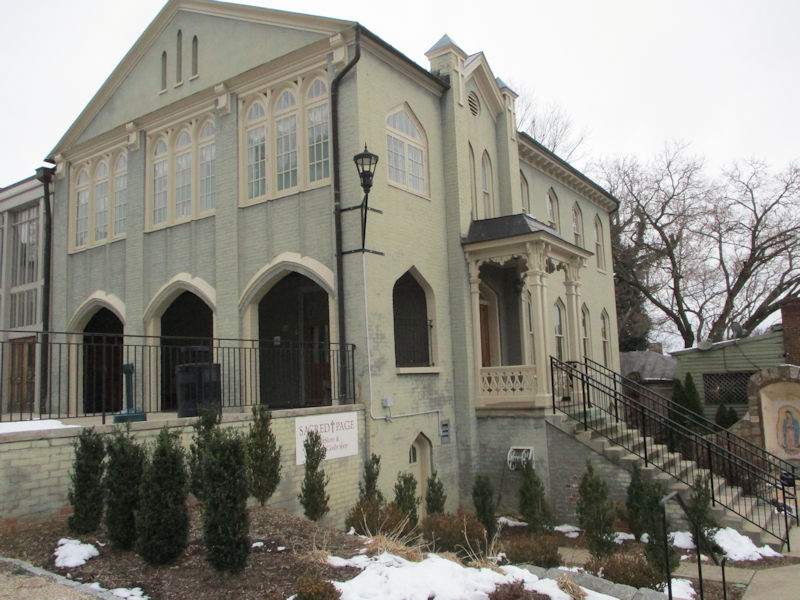
This is a building associated with the St Francis church, built before 1870 as the St Francis Academy, converted into a convent in 1880, and now apparently a bit of everything, offices, classrooms, etc., as far as we can tell from peeking in the windows.

But it's got this quiet little coin or corner for meditation or whatever, joined by some little memorial stones placed by patrons, with however . . .
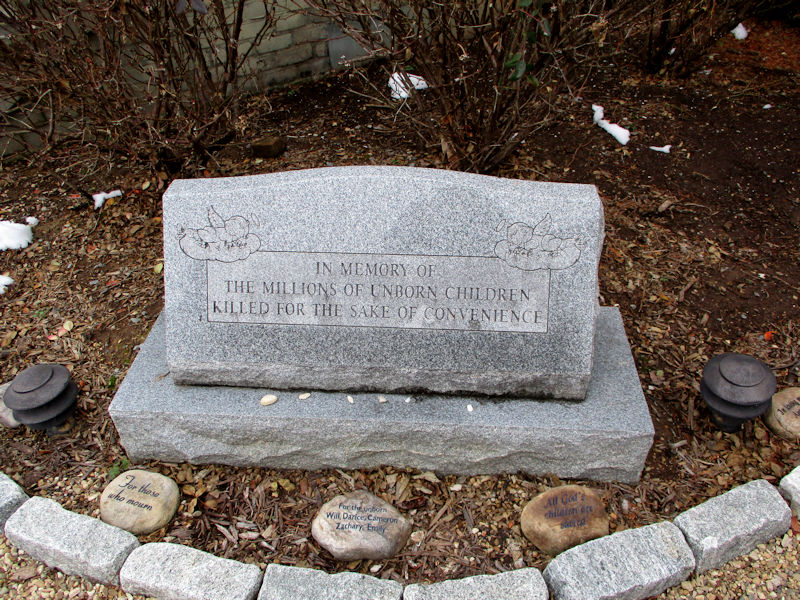
. . . one that's just downright nasty.
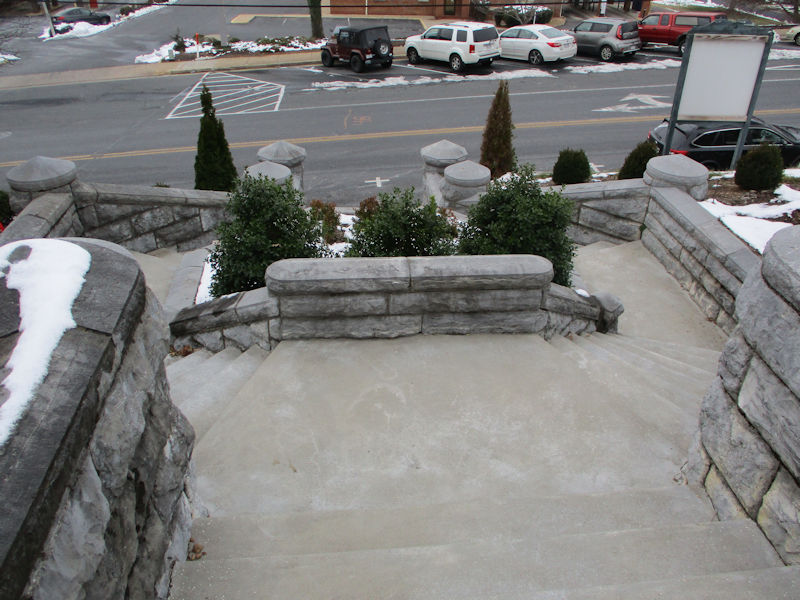
We do love our symmetries -- that's the stairway to the street down from the conventish-thing, and there's another down from the church itself.
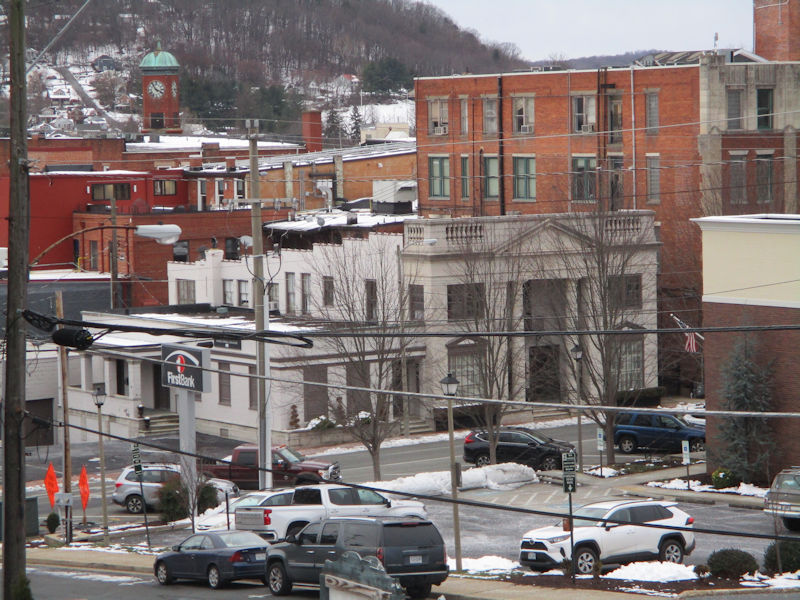
That ponderously elegant building on W. Frederick is the Hamrick Funeral Home (dominating the scene below our front window) -- it's apparently a branch campus of a larger institution in Waynesboro and perhaps elsewhere, because we've seen scarcely more than three services here in the past 2½ years.
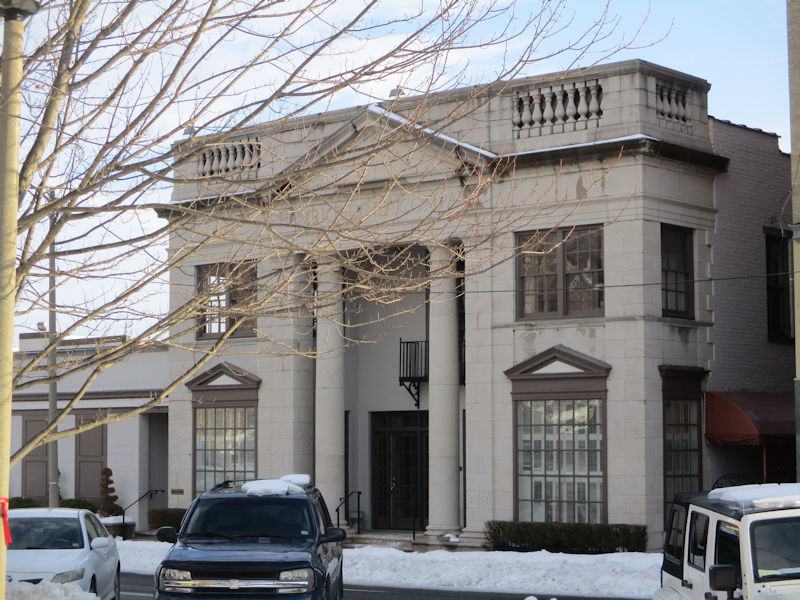
Putting aside the fact that we've never understood why such enterprises are called 'funeral homes', it's not like someone's being sent to a 'foster home' or a 'nursing home' or a 'retirement home' or an assisted-living 'rest home'. They're mostly dead. Normally, except for the funeral, they're just passing through.
Nonetheless, it's a pity that this interesting building and its large parking lot are so woefully underused, because that looks like . . .
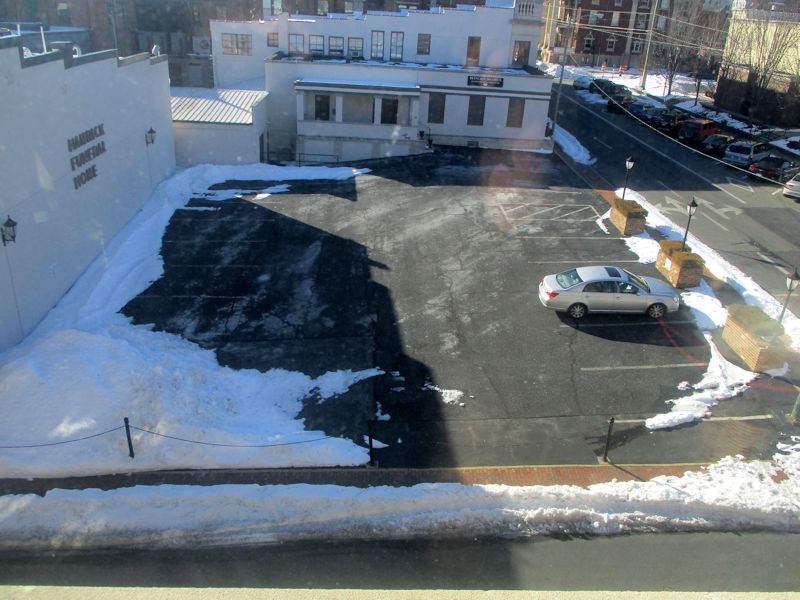
. . . there are 16 completely vacant parking slots (vere 15, because the camera museum man is allowed to park there every day. So that's maybe 30 additional park benches to sit reading on. At our doorstep!
What's next, then? A probably-new trail at the Augusta Springs Wetlands
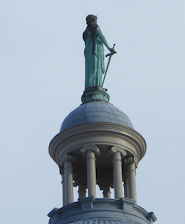 Dwight Peck's personal website
Dwight Peck's personal website

















































